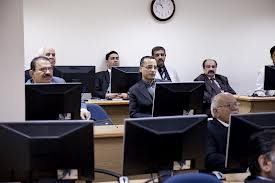According to the Pew Research Center, 63 percent of the U.S. workforce is composed of professional learners. These individuals have taken a course or gotten additional training during the past year to improve their job skills to advance their careers.
While much of this learning is voluntary, a considerable amount of continuing education (CE) is required to maintain a professional license. In fact, Pew found that of those 63 percent of professional learners, 57 percent do so to obtain a license or certification for their jobs.
For the membership organizations that represent these professions, the playing field for offering CE programs continues to evolve. Leaders of four professional membership organizations (architecture, real estate, finance and law) talked about how they are meeting members’ needs and maneuvering the changes in CE creation and delivery.
Stephen Martin, managing director of professional development & resources, The American Institute of Architects, Washington, D.C.
Q. How has CE changed at your organization over the past five years?
A. There’s a much higher demand for quality at an affordable price. Our members don’t want broad and shallow. They’re looking for much deeper content dives. People are looking for “just-in-time” information, which drives up demand for online courses that can be taken anywhere, anytime and, increasingly, on any device.
Q. What’s the biggest challenge for your organization in providing CE?
A. That CE isn’t about just checking a box to meet a requirement. It should be about lifelong learning. While many of our members are moving in this direction, we also have a sizable number who see CE as a burden. We’re addressing this by improving the quality of our courses and examining new delivery models.
Q. How is your CE being consumed?
A. It’s mostly though traditional classroom, face-to-face settings. About 30 percent is through online offerings.
Q. What percent of your organization’s resources are devoted to CE?
A. The AIA has a CE staff of nine, out of 220 employees, responsible for CE. This includes a network of more than 3,500 providers.
Q. How will the landscape look in 10 years?
A. We’re moving toward more on-demand and tailored offerings. Alternate delivery models and shorter blocks of instruction will allow for more flexibility and choice to meet CE requirements.
Maureen Murphy, director of professional development, New Jersey REALTORS
Q. How has CE changed for your organization over the past five years?
A. New Jersey real estate CE requirements were instituted in 2011. We revamped our course catalog to include those that fit within the approved topic categories set forth by the N.J. Real Estate Commission and worked with our instructors to customize the learning experience for members.
Q. What’s the biggest challenge for your organization in providing CE?
A. Advances in learning platforms, provider competition, and delivering a variety of quality education that interests a diverse membership.
Q. How is your CE being consumed?
A. Primarily online, with the exception of programs offered at our annual convention. Many local Realtor boards offer in-person, classroom training for members.
Q. What are your members asking for with respect to CE?
A. They want free or low-cost access to timely, relevant industry information that benefits them in their day-to-day business activities. They also want to earn professional designations and certificates, to become an expert in certain market areas and let potential clients know of it. They want to interact with instructors, subject matter experts, and like-minded members via online discussion forums, plus live events that focus on education as well as networking.
Q. How will the CE landscape look in 10 years?
A. We expect more opportunities for customized learning plans from multiple providers that facilitate a culture of lifelong learning. We also anticipate additional industry designations and certificates – indicating a member’s skills and expertise on a particular subject or niche market. We hope there will be a greater speed-to-market philosophy on courses of critical issues.
Andrej Suskavcevic, president & CEO, Financial Executives International
Q. How has CE changed at your organization over the past five years?
A. CE has crystalized around three pillars: (1) career management; (2) technical skills; and (3) leadership development. Members also crave information on private company issues.
Q. What’s the biggest challenge for your organization in providing CE?
A. Offering price and quality differentiation in a crowded field; providing content from the practitioner’s point of view; and competing for peoples’ time.
Q. How is your CE being consumed?
A. The vast majority is still live, in-person, as well as chapter networking events. Webcasts are a significant and growing platform.
Q. What percent of your organization’s resources are devoted to CE?
A. While I don’t have a specific percentage, I can tell you everything we produce is tied to CE.
Q. How will the landscape look in 10 years?
A. There will be a continued march to digital content delivery along with provider consolidation, like we saw in the Kaplan acquisition of Smart Pros. It’s certainly a growing part of our business. Free CE doesn’t necessarily mean quality CE, and we’ve found that people will spend on quality education.
Angela C. Scheck, executive director, New Jersey State Bar Association
Q. How has CE changed for your organization over the past five years?
A. Since 2009, CE became mandatory for all licensed attorneys practicing in the state. The New Jersey State Bar Association saw that as an opportunity and merged with the New Jersey Institute for Continuing Legal Education, the state’s leader in CLE for more than 50 years.
Q. What’s the biggest challenge for your organization in providing CE?
A. Meeting and successfully managing the expectations of customers that range from 25 to 70 years old. The way people consume information is changing to the mobile format. Many members prefer short bursts of information, a faster pace, and information that is easily summarized.
Q. How is your CE being consumed?
A. The vast majority attend some of our in-person courses. Our on-demand programs, which can be accessed electronically, represent about 25 percent of our CE.
Q. What are your members asking for with respect to CE?
A. Practical strategies, recent developments, changes in the law, and potential challenges. They also look to us to provide that information in convenient locations and a wide variety of formats.
Q. How will the CE landscape look in 10 years?
A. It’ll be important to find the right balance between in-person programs that offer colleague interaction and a hands-on learning experience versus online programming for Millennial attorneys who want on-demand programming to accommodate their personal and professional needs.
Only those who adapt and provide value to their customers will thrive. New technology will continue to drive providers to adapt to new user preferences that we haven’t even identified yet.
David N. Plaskow, M.B.A., is a marketing/communications professional with nearly 20 years of experience working for member-based nonprofits. His email is [email protected]











